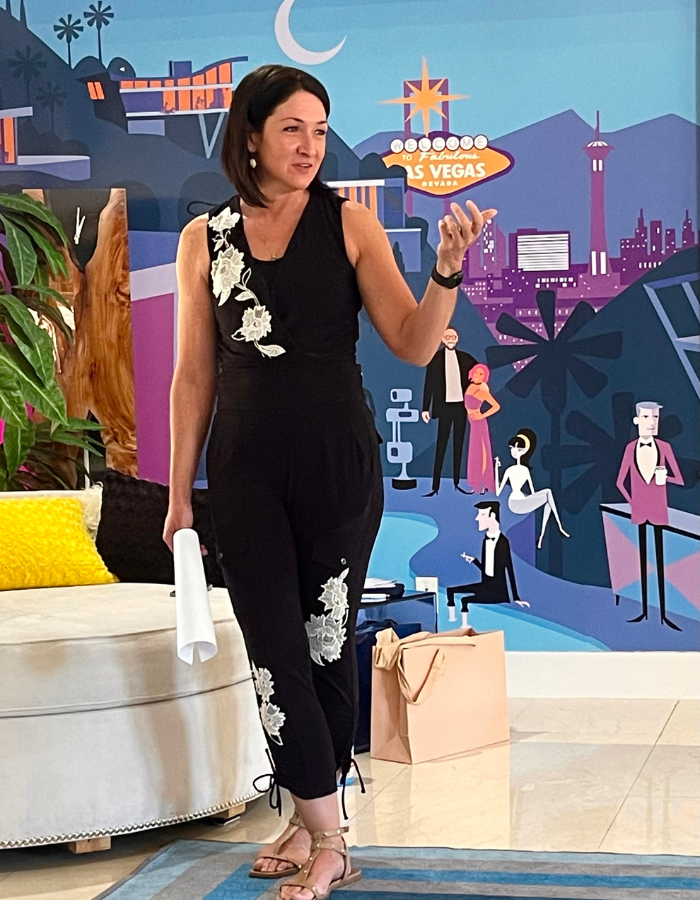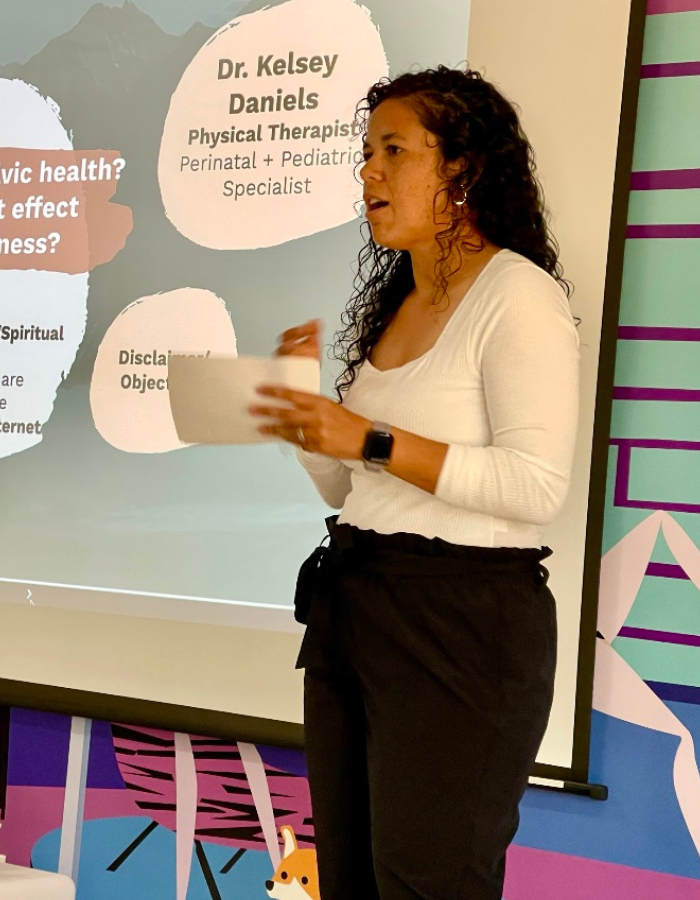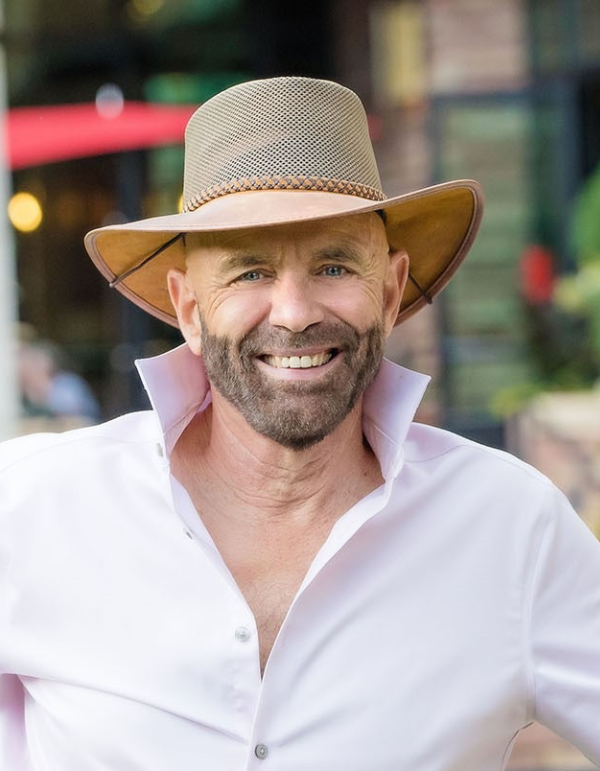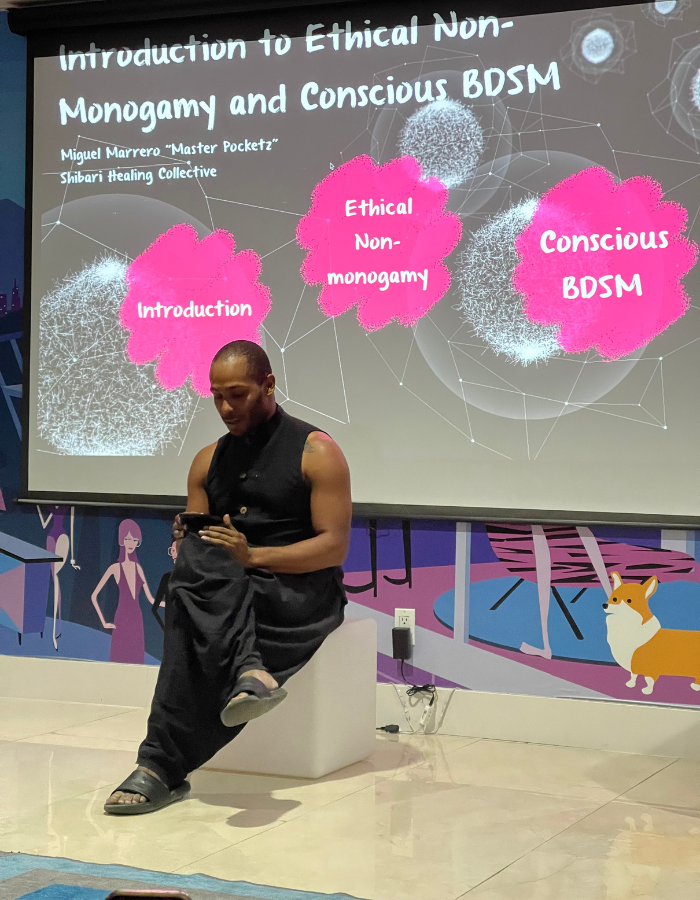
Dr. Amber Hull, founder of Artemis Luxury Wellness, was the keynote speaker at our retreat, bringing her 16 years of experience in clinical research, academic medicine, and private practice to bear on the topic of Human Sexuality and Relationships.
She discussed the medical aspects of sexual health, including the physical and emotional transition to parenthood, medical conditions influencing libido, and recent trends in preventing sexually transmitted infections (STIs).
In her address, Dr. Hull critiqued the narrow range of clinical education that’s offered in medical training regarding sexual health. She contrasted the sparse sex education provided in the American educational system (from primary through post-doctoral levels) with the comprehensive ‘Long Live Love’ program in the Netherlands; underscoring the need for a more holistic approach to topics like pleasure and consent.
Dr. Hull also spoke about how the adult industry manages sexual health through the PASS system. This program ensures regular STI testing for adult film performers; reinforcing the importance of routine health screening.
Focusing on the needs of new mothers, Dr. Hull highlighted the limitations of current for-profit healthcare settings in addressing the physical and emotional transition following childbirth. She also challenged the standard advice for resuming sexual activity post-pregnancy; advocating for an individualized approach that may extend beyond the typically suggested six weeks.
She discussed how anticipating partnered intimacy can motivate individuals to maintain their physical health and appearance. She explored the role of neurotransmitters in mental and sexual health. The session included a critique of dating apps as a mechanism of monetizing the human desire for connection.
Dr. Hull outlined the goals of Artemis, which include mindful exploration of attachment theory, promoting maternal and pelvic floor health, and addressing menopause-related changes to women’s sexual function. Despite the uptick in use of digital platforms for healthcare delivery, she stressed the importance of in-person consultations.
The presentation concluded with a question and answer session. Notably, one question asked about the best methods for delivering sexual health education to children and new mothers, prompting a discussion about options for sensitive and age appropriate conversations.
Focusing on the needs of new mothers, Dr. Hull highlighted the limitations of current for-profit healthcare settings in addressing the physical and emotional transition following childbirth. She also challenged the standard advice for resuming sexual activity post-pregnancy; advocating for an individualized approach that may extend beyond the typically suggested six weeks.
She discussed how anticipating partnered intimacy can motivate individuals to maintain their physical health and appearance. She explored the role of neurotransmitters in mental and sexual health. The session included a critique of dating apps as a mechanism of monetizing the human desire for connection.
Dr. Hull outlined the goals of Artemis, which include mindful exploration of attachment theory, promoting maternal and pelvic floor health, and addressing menopause-related changes to women’s sexual function. Despite the uptick in use of digital platforms for healthcare delivery, she stressed the importance of in-person consultations.
The presentation concluded with a question and answer session. Notably, one question asked about the best methods for delivering sexual health education to children and new mothers, prompting a discussion about options for sensitive and age appropriate conversations.

Dr. Kelsey Daniels, a Doctor of Physical Therapy (DPT), wife, and mother of two focuses on pregnant and postpartum mothers in her mobile, direct-pay private practice. Her presentation centered around the blend of female pelvic health and sexual wellness.
Dr. Daniels outlined how pelvic floor physical therapy supports sexual health, drawing on her own experiences of unmedicated vaginal births. She discussed the different functions of the pelvic floor and addressed the lack of knowledge about body parts, particularly in relation to the pelvic area.
She addressed sexual health concerns in both female and male populations, including the impact of anatomy (“hardware”) and the influence of physiological functions (“software”) of our body that work towards pleasure, orgasm, and intimate connection. She referred to Emily Nagoski’s “Dual control model,” which includes ‘accelerator’ and ‘brakes’ as aspects that can respectively enhance and limit sexual pleasure.
Daniels discussed various factors that can affect sexual wellness, including the importance of the environment, the role of stress and affection, and the significance of breathwork. She also discussed the potential advantages and limitations of social media and the internet in sexual health education.
She touched upon menopausal health and recommended resources like the “Menopause Manifesto” by Jen Gunter. Daniels also discussed how to use health savings accounts (HSAs) and flexible spending accounts (FSAs) to finance access to pelvic floor physical therapy.
The talk covered myths and misunderstandings about sexual health, the role of communication between partners, and the inadequacy of “dyspareunia” or “painful intercourse” as a diagnosis. Daniels stressed the importance of understanding our bodies, which is not a skill usually taught to us in clinical or educational settings.
The Q&A session addressed questions about the role of physical therapists in sexual health, resources about sex in the context of physical disabilities, ergonomic sexual practices, and methods for educating people with spatial awareness difficulties. Dr. Daniels acknowledged that no perfect advice can be given in an hour and highlighted the need for ongoing support to break generational stigma and maintain wellness.
https://www.bemobile.live
IG: the.mobility.project
Daniels discussed various factors that can affect sexual wellness, including the importance of the environment, the role of stress and affection, and the significance of breathwork. She also discussed the potential advantages and limitations of social media and the internet in sexual health education.
She touched upon menopausal health and recommended resources like the “Menopause Manifesto” by Jen Gunter. Daniels also discussed how to use health savings accounts (HSAs) and flexible spending accounts (FSAs) to finance access to pelvic floor physical therapy.
The talk covered myths and misunderstandings about sexual health, the role of communication between partners, and the inadequacy of “dyspareunia” or “painful intercourse” as a diagnosis. Daniels stressed the importance of understanding our bodies, which is not a skill usually taught to us in clinical or educational settings.
The Q&A session addressed questions about the role of physical therapists in sexual health, resources about sex in the context of physical disabilities, ergonomic sexual practices, and methods for educating people with spatial awareness difficulties. Dr. Daniels acknowledged that no perfect advice can be given in an hour and highlighted the need for ongoing support to break generational stigma and maintain wellness.
https://www.bemobile.live
IG: the.mobility.project

With over a decade of experience in clinical sexology, Charlee Davis has dedicated her life to expanding knowledge and fostering healthier relationships and self-pleasure practices. Her guiding philosophy, “If you can’t talk about it, you shouldn’t be doing it,” has led many couples to start open conversations about their sexual desires, fears, and boundaries.
In her discussion she stressed the importance of honest exploration in understanding one’s own sexual preferences and how these might evolve over time.
Charlee also debunked myths about kink, such as the notion that it involves only pain or that it always stems from trauma. She elaborated on the role of trust and communication in healthy kink practices, and how these can be both healing and transformative when done right.
.
Her discourse on female orgasm was equally enlightening; breaking down misconceptions and explaining the anatomy of the G-spot and squirting. She shared valuable techniques for stimulation and emphasized the importance of understanding and exploring one’s own body. Charlee also explained physiological changes that can occur post-pregnancy and introduced concepts like “sensate focus” for enhancing sexual experiences.
Questions raised at the end of the discussion dealt with matters of trust in relationships and whether fetishes were psychologically less healthy than kinks. The session ended without a clear consensus on these issues, emphasizing the complexity and individuality of human sexual experiences.
Her discourse on female orgasm was equally enlightening; breaking down misconceptions and explaining the anatomy of the G-spot and squirting. She shared valuable techniques for stimulation and emphasized the importance of understanding and exploring one’s own body. Charlee also explained physiological changes that can occur post-pregnancy and introduced concepts like “sensate focus” for enhancing sexual experiences.
Questions raised at the end of the discussion dealt with matters of trust in relationships and whether fetishes were psychologically less healthy than kinks. The session ended without a clear consensus on these issues, emphasizing the complexity and individuality of human sexual experiences.

In her presentation titled “I Want It That Way”: Learning the Language to Share Intimate Preferences, Alice Little, an intimacy entrepreneur and successful legal sex worker, highlighted the importance of effective communication and mindfulness in fostering satisfying sexual relationships.
As a prominent advocate for sex positivity and women’s rights, Alice’s experience and insights drew from her significant interactions with clients and her role in various sex-positive movements.
She stressed the importance of expressing one’s needs, wants, and desires within intimate relationships, highlighting how these elements contribute to a fulfilling sexual experience. Alice urged individuals to be mindful of their emotional states and to develop inner dialogues that help them identify their preferred experiences and sensations.
Alice highlighted the importance of feedback during intimacy, suggesting that asking about sensations rather than preferences could lead to more effective communication. She recommended partnered activities and the use of sensory toys for this purpose.
.
Throughout the talk, Alice consistently underscored the necessity of establishing clear and candid communication, even when it feels uncomfortable. This communication should extend to instances where an intimate act is not enjoyed. In these moments, she suggested partners acknowledge the discomfort, express gratitude for the communicated boundary, and check-in with one another to determine the next steps.
In discussing BDSM, Alice emphasized the critical importance of discussing boundaries, limits, and medical histories before engagement.
Alice addressed the issue of “dead bedrooms” or relationships where intimacy has dwindled. She advised individuals facing this challenge to evaluate their desire to improve the situation. She encouraged open conversation about changes in sexual preferences or situations, such as post-childbirth changes, and suggested planning for sex if spontaneous intimacy was challenging.
Addressing the role of porn in shaping sexual preferences, Alice urged caution against attempting to recreate scenes from adult films without understanding each other’s comfort levels. Instead, she suggested using such imagery as a tool for for opening a dialogue about individual likes and dislikes.
She closed her discussion by emphasizing the value of a curious, open-minded approach to intimacy. After the talk, questions were taken from the audience, further enriching the conversation about sexual communication and intimacy.
https://www.thealicelittle.com
IG: thealicelittleofficial
Throughout the talk, Alice consistently underscored the necessity of establishing clear and candid communication, even when it feels uncomfortable. This communication should extend to instances where an intimate act is not enjoyed. In these moments, she suggested partners acknowledge the discomfort, express gratitude for the communicated boundary, and check-in with one another to determine the next steps.
In discussing BDSM, Alice emphasized the critical importance of discussing boundaries, limits, and medical histories before engagement.
Alice addressed the issue of “dead bedrooms” or relationships where intimacy has dwindled. She advised individuals facing this challenge to evaluate their desire to improve the situation. She encouraged open conversation about changes in sexual preferences or situations, such as post-childbirth changes, and suggested planning for sex if spontaneous intimacy was challenging.
Addressing the role of porn in shaping sexual preferences, Alice urged caution against attempting to recreate scenes from adult films without understanding each other’s comfort levels. Instead, she suggested using such imagery as a tool for for opening a dialogue about individual likes and dislikes.
She closed her discussion by emphasizing the value of a curious, open-minded approach to intimacy. After the talk, questions were taken from the audience, further enriching the conversation about sexual communication and intimacy.
https://www.thealicelittle.com
IG: thealicelittleofficial

In his insightful presentation titled “Unlocking Erotic Potential through Tantra”, Mark Casey, a Somatica trained Sex & Relationship Coach and certified Transformational Coach, offered a comprehensive overview of tantra as a tool for enhancing sexual experiences and relationships.
As an author and experienced coach, Mark’s approach involves teaching singles and couples to fully connect their desires with their body, mind, and heart through experiential practices.
He elaborated on the concept of tantra, discussing its etymology and its various types. Tantra, derived from “Tan” and “Tra” implying the weaving of a loom and tool respectively, is understood as energy as a tool. He distinguished between white tantra (internal practice without sex), red tantra (engagement with a partner), pink tantra (presence through practices like breathing, eye gazing), and black tantra (sex magic for manifestation).
.
Mark detailed the fundamentals of tantra, such as the critical role of breath in directing energy and staying present during lovemaking. He emphasized the importance of breaking free from shame associated with sex and balancing masculine and feminine energies within us.
Finally, Mark addressed various types of orgasms and the role of tantra in enhancing orgasmic experiences. He introduced the concept of orgasmic meditation – a structured, timed practice involving light stroking generally on the vulva/clitoris. This, he said, helps to rewire the nervous system. He explored the topic of male orgasm without ejaculation and how tantra can help men gain control over their sexual experiences.
Overall, Mark’s presentation served as an enlightening exploration into the potential of tantra as a transformative tool in enhancing sexual experiences and intimacy.
https://www.youreroticpotential.com
IG: youreroticpotential
Mark detailed the fundamentals of tantra, such as the critical role of breath in directing energy and staying present during lovemaking. He emphasized the importance of breaking free from shame associated with sex and balancing masculine and feminine energies within us.
Finally, Mark addressed various types of orgasms and the role of tantra in enhancing orgasmic experiences. He introduced the concept of orgasmic meditation – a structured, timed practice involving light stroking generally on the vulva/clitoris. This, he said, helps to rewire the nervous system. He explored the topic of male orgasm without ejaculation and how tantra can help men gain control over their sexual experiences.
Overall, Mark’s presentation served as an enlightening exploration into the potential of tantra as a transformative tool in enhancing sexual experiences and intimacy.
https://www.youreroticpotential.com
IG: youreroticpotential

In his engaging presentation titled “Ethical Non-Monogamy 101”, Miguel Marrero, also known as Master Pocketz, delved into the themes of ethical non-monogamy (ENM), conscious BDSM, and the Japanese art of Shibari. As an artist, intimacy coach, and experienced practitioner of Shibari and polyamory, Miguel creates artistic, meditative, and erotic experiences founded on energy and intention setting.
Miguel started by providing an overview of Ethical Non-Monogamy (ENM), a relationship style characterized by open communication, trust, respect, self-awareness, intention, and shared growth. He emphasized that polyamory is a lifestyle choice that encapsulates all these aspects.
The discussion then shifted towards the concept of conscious BDSM. He stressed the importance of communication, negotiation, self-reflection, personal growth, and consent in these alternative lifestyle practices. Miguel drew analogies between BDSM and driving, stating that just as one decides where they want to go while driving, conscious BDSM involves a deep understanding of connection, power exchange, and motivations.
.
He went on to dispel some misconceptions associated with BDSM, such as it being abusive, non-consensual, and solely about pain and domination.

Miguel doing an intricate shibari suspension.
He underscored that BDSM is centered around consent and negotiation, with clear boundaries and safe words in place. He also highlighted the importance of aftercare in providing comfort and support and described how BDSM could alter one’s relationship with pain. Furthermore, he argued against the stigma that BDSM is a reflection of personal trauma or mental illness, stating that it is more a form of bondage-directed somatic medicine that can be affected meaningfully by one’s intentions.
As part of his presentation, Miguel performed a live demonstration of Shibari, an art form he has been practicing for over six years. His goal through this and all his rope encounters is to create a safe space for anyone looking to experience Shibari as a form of somatic therapy. His commitment to safety, comfort, and intention-setting during these sessions resonated throughout his presentation.
https://www.knottyexperience.com
IG: shibarihealingcollective
He went on to dispel some misconceptions associated with BDSM, such as it being abusive, non-consensual, and solely about pain and domination. He underscored that BDSM is centered around consent and negotiation, with clear boundaries and safe words in place. He also highlighted the importance of aftercare in providing comfort and support and described how BDSM could alter one’s relationship with pain. Furthermore, he argued against the stigma that BDSM is a reflection of personal trauma or mental illness, stating that it is more a form of bondage-directed somatic medicine that can be affected meaningfully by one’s intentions.

Miguel doing an intricate shibari suspension
As part of his presentation, Miguel performed a live demonstration of Shibari, an art form he has been practicing for over six years. His goal through this and all his rope encounters is to create a safe space for anyone looking to experience Shibari as a form of somatic therapy. His commitment to safety, comfort, and intention-setting during these sessions resonated throughout his presentation.
https://www.knottyexperience.com
IG: shibarihealingcollective








